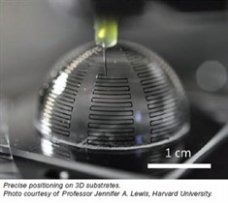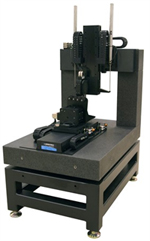 Dispensing involves printing organic and inorganic components on various substrates including paper, plastics and textiles. Dispensing encompasses applications including printed electronics, 3D printing and conformal coatings. Overall system accuracy and throughput are important requirements in these applications to dispense along complex contours. Aerotech's product line is specifically designed with these requirements in mind. Common configurations include gantries, split bridge assemblies and 5 - 6 axis degree of freedom (DOF) systems.
Dispensing involves printing organic and inorganic components on various substrates including paper, plastics and textiles. Dispensing encompasses applications including printed electronics, 3D printing and conformal coatings. Overall system accuracy and throughput are important requirements in these applications to dispense along complex contours. Aerotech's product line is specifically designed with these requirements in mind. Common configurations include gantries, split bridge assemblies and 5 - 6 axis degree of freedom (DOF) systems.
Printed electronics involves printing functional electronic circuits, such as OLED displays, electroluminescent lighting, stretchable electronics, wearable sensors, RFID tags and photovoltaic panels on a variety of media. Aerotech motion systems are built for reliability and flexibility, allowing you to bring printed electronics concepts to reality.
 6-Axis DOF Dispensing System
6-Axis DOF Dispensing System
- Split axis, 6 degrees of freedom assembly allows dispensing on complex contours
- Precision rotational axis of intersection alignments minimize three dimensional stack-up errors at the workpoint.
- Multi-axis position synchronized output (PSO) couples your dispensing head directly to the encoder feedback for consistent deposition, regardless of the contour complexity or velocity variability, which allows for the highest possible throughput.
- Direct-drive rotary axes exhibit high acceleration and zero backlash for ultra-smooth velocity regulation.
- Dual-head configuration allows for two tool points which in turn doubles the process capabilities over the same work area.
- Aerotech controllers provide coordinated motion between work-points, creating harmonized motion.
- Systems offered in both “T” style and “H” style gantries (“T” style shown below).
 Biological Dispensing
Biological Dispensing
Printing organic structures has opened up new frontiers in medical research. Printing 3D cell structures provides a better model for studying interactions between cells and growth factors or chemical agents as opposed to traditional 2D cell cultures grown in a dish.
Additionally, printing bone scaffolds helps cells heal in severe fractures. Here, pore size of the scaffold is critical to allow cells the ideal environment to grow. Typical pore sizes are hundreds of microns in diameter and require micron-level precision to construct, a core competency of Aerotech systems.
Compact 3-Axis Assemblies
- Ultra-compact, modular direct-drive axes exhibit excellent in-position stability with no hysteresis or backlash, enabling submicron accuracy and repeatability for precise deposition.
- Nanometer performance (1 nm step size) in a large-travel footprint.
- Compact design, pneumatic Z.
- Anti-creep crossed-roller bearings allow for smooth velocity regulation.






